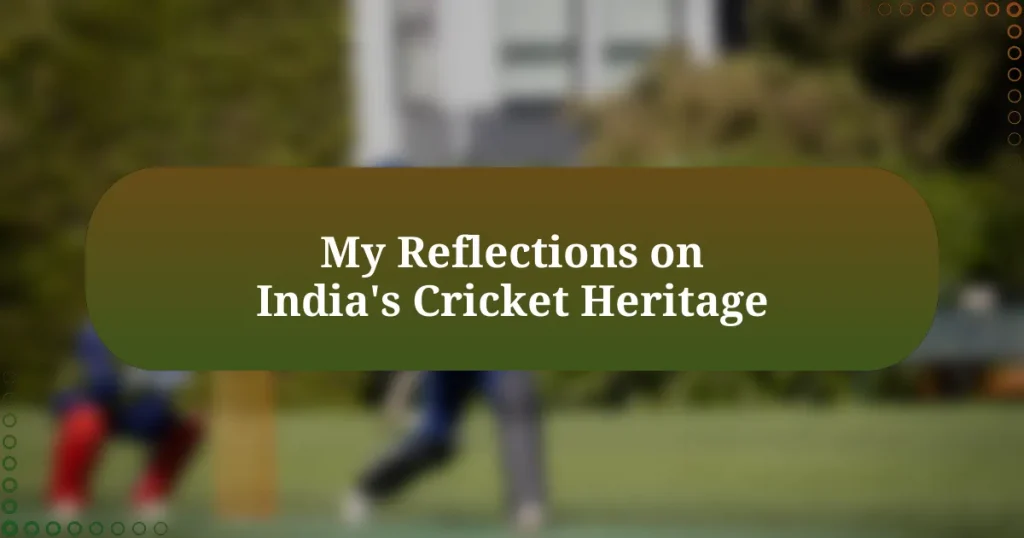Key takeaways:
- Cricket in India transcends sport, uniting diverse communities and serving as a symbol of national pride, particularly during significant events like the 1983 World Cup.
- The game has historical significance, acting as a form of resistance during colonial times and evolving into a rallying point for unity and collective identity.
- Personal experiences and memories associated with cricket cultivate deep emotional connections and life lessons, emphasizing teamwork, perseverance, and the joy of the game.
- The future of cricket in India looks promising, driven by youth enthusiasm, technological advancements, and global connectivity, which could reshape the sport’s landscape.
Author: Elena Whitaker
Bio: Elena Whitaker is an acclaimed author known for her compelling narratives that explore the intricacies of human relationships and the complexities of modern life. With a background in psychology and literature, her work often weaves elements of introspection and emotional depth, resonating with readers across various genres. Elena’s debut novel, Echoes of the Heart, received widespread praise for its rich character development and poignant storytelling. When she’s not writing, Elena enjoys hiking in nature and hosting book clubs, where she inspires discussions about the literary arts. She currently resides in the Pacific Northwest with her family and a mischievous rescue dog.
Understanding cricket in India
Cricket in India isn’t just a sport; it’s a festival that brings people together across diverse cultures. I remember the palpable excitement in my neighborhood every time the Indian team played in the World Cup. The streets would erupt into cheers, and it felt as though we were all part of something monumental—like we were fighting battles together through the screen.
The passion for cricket isn’t merely about the game; it’s woven into the very fabric of day-to-day life. I often find myself pondering how many families gather around their television sets, eyes glued to the match, with plates of snacks and drinks within easy reach. Isn’t it fascinating how a simple game can cultivate such a sense of community and belonging?
The historical journey of cricket in India—from its colonial roots to becoming a symbol of national pride—makes it even more intriguing. I can’t help but reflect on how the narratives of legendary players like Kapil Dev and Sachin Tendulkar have inspired generations. Their stories teach us that cricket is not just about runs and wickets, but also about dreams, resilience, and the relentless pursuit of excellence. What draws you to cricket—its competitive spirit or the stories behind the players?
Historical significance of cricket
Cricket’s historical significance in India stretches back to the 18th century when British colonists brought the game to the subcontinent. As I think back to the stories shared by my grandfather, I realize how cricket once acted as a subtle form of resistance against colonial authority. The sport became a means for Indians to claim their identity, illustrating that even in the face of oppression, we could carve out a space to celebrate our own heroes.
The 1947 independence movement profoundly intertwined with cricket, as matches became platforms for national fervor. I remember a particular match scheduled on the eve of Independence Day; the atmosphere was electric, almost as if everyone understood that victory on the cricket field meant a victory for the nation itself. What strikes me most is how cricket transitioned from a colonial pastime into a rallying point for unity and pride.
Another captivating aspect of cricket’s history in India is the role it played during the socio-political upheavals, particularly in shaping public sentiment. Reflecting on the days of the 1983 World Cup victory, I can still feel the emotions that swept across the nation, uniting people irrespective of their backgrounds. Doesn’t it amaze you how cricket has, time and again, mirrored the aspirations and struggles of our society?
Major cricketing events in India
When I think of major cricketing events in India, the 1983 Cricket World Cup holds a special place in my heart. I was just a child then, but the joy and pride that enveloped our home when India lifted the trophy felt monumental. It was more than just a win; it ignited a passion for cricket that brought families and friends together, celebrating our nation’s strength and spirit. How can one forget that iconic moment when Kapil Dev’s team transformed the underdog narrative into a triumphant tale?
Fast forward to 2007, and the inaugural T20 World Cup revealed yet another layer of excitement in cricketing events. I vividly recall gathering with friends to watch the final against Pakistan, the atmosphere charged with anticipation. The sight of our team triumphing in a format that was fresh and thrilling felt like a new dawn for Indian cricket. It made me realize how adaptable and innovative our players are, capable of embracing challenges and evolving with the game.
Then there’s the Indian Premier League (IPL), a game-changer for cricket in India. I often find myself reminiscing about the first season in 2008, when the city streets were transformed into vibrant fan zones. The IPL not only showcased local and international talent but also breathed fresh life into the sport, linking it with modern entertainment culture. Doesn’t it just spark a sense of wonder to think how cricket has intertwined with our everyday lives, transcending beyond just a sport?
Impact of cricket on culture
The impact of cricket on Indian culture is profound and multifaceted. I remember the vibrant scenes on the streets during the World Cup seasons when everyone, irrespective of age or background, would unite in support of our team. It was like a festival, with neighbors sharing snacks and stories, and the excitement would flow through the air. Doesn’t it feel magical how cricket can dissolve barriers, creating a tapestry of shared dreams and aspirations?
In many ways, cricket has become a shared language among us. I often find myself discussing match strategies and player performances with friends and colleagues, regardless of whether we support the same team. Those conversations foster connections that extend beyond the game itself, often leading to deeper friendships and a sense of community. Isn’t it fascinating how a simple game can transform into a pivotal aspect of our social fabric?
Moreover, the celebration of cricket is reflected in our festivals and everyday lives. Whether it’s wearing jerseys during matches or kids setting up makeshift pitches in local parks, the sport is interwoven with our cultural identity. Occasionally, I’ll catch myself reminiscing about the thrill of playing cricket in narrow lanes as a kid, and I realize how those moments shaped my love for the game. Doesn’t every cricket match tell a story, one that resonates within us long after the final ball has been bowled?
My personal connection to cricket
As I think back on my childhood, cricket was more than just a game; it was a rite of passage. I vividly remember the day I received my first bat as a birthday gift. Holding that piece of wood felt transformational; it was as if I held the key to unlocking a world of adventure and camaraderie. Have you ever felt that rush of excitement when embarking on something new? That day marked the beginning of many summer afternoons spent playing with friends, each match breathing life into our dreams of becoming cricketing stars.
Every match brings back a flood of memories, particularly those weekends spent huddled in front of the TV with my family. The tension in the room, the shared cheers, and the collective sighs after a missed catch were moments that forged unbreakable bonds. I still laugh when recalling how my grandmother would analyze the match with the same fervor as a seasoned commentator, proving that cricket really is for everyone. Can you recall a time when a sporting event brought your family together?
Even today, there’s an inexplicable thrill when I step onto a cricket field, whether it’s a casual weekend game or a more competitive match. Each time I grip the bat, I feel a connection to all those who have played before me, as if I’m part of a much larger story. The joy of hitting a clean shot or the camaraderie of fielding with teammates adds layers to my connection with the game. Isn’t it incredible how cricket continues to evoke such deep emotions, even years down the line?
Lessons learned from cricket experiences
Experiencing cricket at various levels taught me that perseverance is key, especially when facing a tough opponent. I remember a local tournament where our team struggled early on; it felt disheartening. However, instead of giving up, we rallied together, learning to adapt our strategy. That experience reinforced my belief that teamwork and determination can turn the tide, both on and off the field.
Another vital lesson has been about the importance of sportsmanship. During a particularly heated match, tempers flared, and tensions rose. I found myself in the middle of a disagreement about a close call. Rather than letting it escalate, I chose to extend a hand for a handshake, diffusing the situation. This moment reminded me that respecting opponents enriches the game and fosters friendships that last well beyond the final whistle. Have you ever found common ground in a competitive setting?
Lastly, I’ve learned that cricket is not just about winning; it’s about enjoying the journey. I still cherish the afternoons when my friends and I would play just for the fun of it, with makeshift wickets and laughter echoing in the air. Those carefree moments, filled with creativity and joy, taught me to appreciate the simple pleasures in life. Isn’t it fascinating how sometimes, the memories we create away from the competition are what stay with us the longest?
Future of cricket in India
Looking ahead, I see a vibrant future for cricket in India, fueled by an ever-growing passion among the youth. Just the other day, I watched a group of kids playing cricket in a narrow street in my neighborhood, laughter ringing out as they improvised their game with whatever they could find. It struck me how this spirit of playfulness and creativity can nurture the next generation of cricketers—who will likely take the game to new heights.
The advent of technology is another game-changer, with analytics and data-driven strategies set to redefine the sport. I recall the time when I first encountered a batting app that analyzed every swing I took. The insights were eye-opening, showing me areas for improvement I hadn’t even considered. Imagine how these tools could empower young players across India to refine their skills and evolve faster than ever before.
Moreover, I can’t help but ponder how the increasing global connectivity will influence cricket in India. With platforms like social media, I’ve seen budding players share their journeys and connect with legends of the game. What if this interaction leads to mentorships that bridge the gap between aspiring youngsters and seasoned professionals? It’s thrilling to think about the rich tapestry of talent and experience that could emerge, shaping not just players but also the future identity of Indian cricket.
















